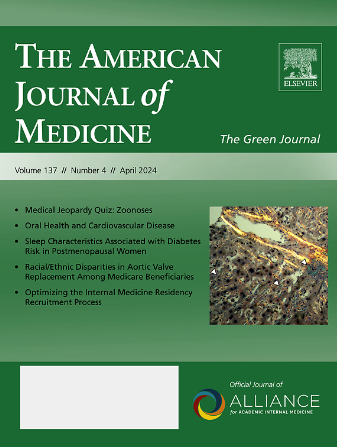Comparative Analysis of First-Line Antihypertensive Treatment Classes
IF 5.3
3区 医学
Q1 MEDICINE, GENERAL & INTERNAL
引用次数: 0
Abstract
Background
The best first-line monotherapy for hypertension remains uncertain, as current guidelines suggest that thiazides, angiotensin-converting enzyme inhibitors (ACEis), angiotensin receptor blockers (ARBs), and calcium channel blockers (CCBs) are appropriate in the absence of specific comorbidities. We aimed to compare the outcomes of first-line antihypertensive classes in a real-life setting with a long follow-up period.
Methods
This nationwide retrospective new-user cohort study included patients insured by the largest health maintenance organization in Israel. We included patients with a new diagnosis of hypertension between 2008 and 2021 who initiated treatment with a single first-line drug for hypertension. Outcomes were assessed with and without propensity score matching for confounding factors. The primary composite outcome was the first occurrence of myocardial infarction (MI), acute coronary syndrome (ACS), stroke, or heart failure (HF).
Results
A total of 97,639 patients initiated antihypertensive treatment with a single drug as first-line therapy. The most commonly prescribed class was ACEis/ARBs (66,717, 68.3%), followed by CCBs (15,922, 16.3%), beta-blockers (BBs, 12,869, 13.2%), and thiazides (2,131, 2.2%). For the primary outcome, the hazard ratios (HRs) for BBs, CCBs, and ACEis/ARBs were 1.44 (95% CI 1.25-1.66), 1.10 (95% CI 0.96-1.27), and 1.13 (95% CI 0.99-1.29), respectively, when compared to thiazides.
Conclusion
When initiating pharmacotherapy for hypertension with a single drug, angiotensin-converting enzyme inhibitors, angiotensin receptor blockers, and calcium channel blockers were associated with similar risk of MI, ACS, stroke, or HF when compared to thiazides, while beta-blockers were associated with increased risk.

一线抗高血压治疗类别的比较分析。
背景:目前的指南建议,在没有特定合并症的情况下,噻嗪类药物、血管紧张素转换酶抑制剂(ACEi)、血管紧张素受体阻滞剂(ARB)和钙通道阻滞剂(CCB)是治疗高血压的最佳一线单药疗法。我们的目的是在长期随访的真实环境中比较一线降压类药物的疗效:这项全国性的新用户回顾性队列研究纳入了以色列最大的健康维护组织的投保患者。我们纳入了 2008 年至 2021 年期间新诊断出高血压并开始使用单一一线药物治疗高血压的患者。在对混杂因素进行倾向评分匹配和未进行倾向评分匹配的情况下,对结果进行了评估。主要综合结果是首次发生心肌梗死(MI)、急性冠状动脉综合征(ACS)、中风或心力衰竭(HF):共有 97,639 名患者开始使用单一药物作为一线降压治疗。最常用的处方药是 ACEi/ARB(66717,68.3%),其次是 CCB(15922,16.3%)、β-受体阻滞剂(BB,12869,13.2%)和噻嗪类药物(2131,2.2%)。就主要结果而言,与噻嗪类药物相比,BBs、CCBs 和 ACEi/ARBs 的危险比(HRs)分别为 1.44(95% CI 1.25 - 1.66)、1.10(95% CI 0.96 - 1.27)和 1.13(95% CI 0.99 - 1.29):结论:在使用单一药物开始高血压药物治疗时,血管紧张素转换酶抑制剂、血管紧张素受体阻滞剂和钙通道阻滞剂与噻嗪类药物相比,发生心肌梗死、急性心肌梗死、中风或高血压的风险相似,而β-受体阻滞剂则会增加风险。
本文章由计算机程序翻译,如有差异,请以英文原文为准。
求助全文
约1分钟内获得全文
求助全文
来源期刊

American Journal of Medicine
医学-医学:内科
CiteScore
6.30
自引率
3.40%
发文量
449
审稿时长
9 days
期刊介绍:
The American Journal of Medicine - "The Green Journal" - publishes original clinical research of interest to physicians in internal medicine, both in academia and community-based practice. AJM is the official journal of the Alliance for Academic Internal Medicine, a prestigious group comprising internal medicine department chairs at more than 125 medical schools across the U.S. Each issue carries useful reviews as well as seminal articles of immediate interest to the practicing physician, including peer-reviewed, original scientific studies that have direct clinical significance and position papers on health care issues, medical education, and public policy.
 求助内容:
求助内容: 应助结果提醒方式:
应助结果提醒方式:


